 Lying down, almost asleep… wait… vibrations, tingling …. I’m…I’m separating …. lifting above my body …. floating above my body, …. looking down I see myself lying there … Who am I? .. I know who I am and I can see my body …. but I’m not in the body….
Lying down, almost asleep… wait… vibrations, tingling …. I’m…I’m separating …. lifting above my body …. floating above my body, …. looking down I see myself lying there … Who am I? .. I know who I am and I can see my body …. but I’m not in the body….
Are these experiences “real” or brain pathology? Could they be “merely dreams.”
Upon awakening from a dream, I realize that my sense of “I” existed in the dream and now exists in the waking state. A previous post questioned whether the same “I” exists in both. In the waking state identity is closely related to our body, as well as our situation, family, profession, and experiences. In the dream state the relations are less clear.
If I experience being outside of my body, and looking down at it, is it the same “I” as in waking and sleeping?
Recent research is shedding light on these questions.
Body Maps
One of the remarkable aspects of the brain is that there is no central place that determines the “I,”or subjective awareness. This function appears to be distributed throughout the brain in many circuits even though it feels as if it is drawn from many sources into one unified experience.
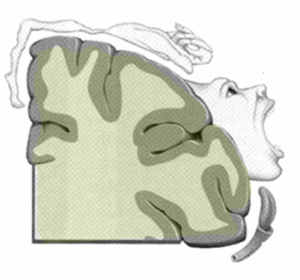 Similarly, the body sense is also distributed in a wide range of body maps that are scattered throughout the brain. A well-known example of a brain map is the sensory homunculus in the cortex. Sensory information from all body parts travel to specific regions of the cortex to be analyzed. Note that in the picture of the sensory homunculus the sensory representation of the mouth, thumb and tongue are much larger than the leg and arm even though the limbs are far greater in actual size. There are, however, many more sensory signals from these three crucial regions than from the relatively simple sensory apparatus of the arm and leg.
Similarly, the body sense is also distributed in a wide range of body maps that are scattered throughout the brain. A well-known example of a brain map is the sensory homunculus in the cortex. Sensory information from all body parts travel to specific regions of the cortex to be analyzed. Note that in the picture of the sensory homunculus the sensory representation of the mouth, thumb and tongue are much larger than the leg and arm even though the limbs are far greater in actual size. There are, however, many more sensory signals from these three crucial regions than from the relatively simple sensory apparatus of the arm and leg.
The brain is constantly mapping the body in multiple ways. When using a tool or a musical instrument our body map changes to include this appendage. An example is the mechanic who can “feel” with the end of the wrench or screwdriver without being able to  see the part under the car. When riding a horse, the horse becomes part of the body map.
see the part under the car. When riding a horse, the horse becomes part of the body map.
Maps are constantly changing. An example occurs when practicing piano. Specific finger maps will grow and merge with others. By looking at virtual reality images of ourselves we can develop a body map with changing shapes such as longer arms. In phantom limb pain maps become distorted.
The brain works with a wide variety of body maps putting them together into a conception of our body, which includes emotional awareness. Like other perceptions expectations determine our body image (see post Limits of the Senses), some viewing themselves as young, old, fat, thin, strong, weak, beautiful, or ugly. Body maps are involved in defining social spaces. In some societies standing closer than a foot is entering intimate body space. The other person entering the intimate personal space then becomes part of the brain’s personal space body map.
Body Consciousness and Sense of Self
Our conscious experiences are bound to a self-identity, which includes the “I” experience and many sensations, thoughts, emotions and experiences associated with this sense of who we are. The body is a big part of this self-image.
The sense of “I” is not understood despite a large number of brain studies focusing on it. Complex multisensory systems appear to give rise to the bodily self-consciousness, which plays an integral part of first person identification. Three aspects seem critical to help define this sense of self: the ability to self-locate, which includes a body sense and a sense of placement in space; a self identify; and a first person subjective experience.
Body image can be easily changed with brain injury. Brain damage has produced a sense of not owning a limb, or thinking a limb belongs to someone else. In some injuries victims identify other people’s limbs as their own. The self, however, is represented as a single entity not a limb. These limb changes do not change this first person experience.
 First person perspective and self-location use some similar and some distinct brain regions. Brain processes related to internal signals such as heartbeat are important information sent to the brain region for emotional awareness that is a critical part of self-identity. Previous posts have discussed the default mode network, the DMN, which is correlated with introspection and self-identity. This aspect of the self identity changes with meditation.
First person perspective and self-location use some similar and some distinct brain regions. Brain processes related to internal signals such as heartbeat are important information sent to the brain region for emotional awareness that is a critical part of self-identity. Previous posts have discussed the default mode network, the DMN, which is correlated with introspection and self-identity. This aspect of the self identity changes with meditation.
Most research on consciousness has focused on visual stimuli processing, which can be either conscious and unconscious. It is not known, for example, how this processing occurs in altered states of bodily consciousness. It is also not known how consciousness or identity relates to language, memory, future planning and prediction, self-narrative, or empathy.
Stimulus for Body Illusions
Bodily illusions have been stimulated in a variety of ways.
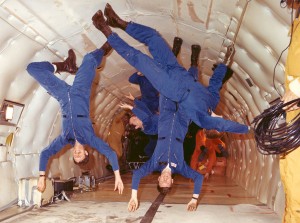 Weightlessness can stimulate body illusions. In space there is a continued sense of up and down although, in fact, it is meaningless. Without gravity multisensory systems disintegrate and direction is determined from the cortex using the same processes that form our perceptions from expectations (see post Limits of the Senses). Vertical orientation disappears in free floating with eyes closed. The most common illusion is being upside down, which has led to accidents in space.
Weightlessness can stimulate body illusions. In space there is a continued sense of up and down although, in fact, it is meaningless. Without gravity multisensory systems disintegrate and direction is determined from the cortex using the same processes that form our perceptions from expectations (see post Limits of the Senses). Vertical orientation disappears in free floating with eyes closed. The most common illusion is being upside down, which has led to accidents in space.
People with sleep paralysis experience floating outside their bodies. Sleep deprivation is another state that will trigger dream like experiences while waking. A REM like state during sleep paralysis involves a feeling of flying or moving while the body is not moving. The brain eliminates this conflict with a change of perception.
Out of Body Experiences
Many well known people have described out of body experiences, known as OBEs, including Fyodor Dostoevsky, Oscar Wilde, and Edgar Alan Poe. A wide variety of circumstances have been associated with OBE’s.
OBE’s are often associated with seizures, migraines, strokes, brain tumors, brain trauma, psychoactive drugs (ketamine, dextromethorphan cough syrup, amphetamine, psychedelics), dehydration, sleep paralysis, lucid dreaming and near death experiences.
Both sensory overload in crisis (childbirth, accidents, extreme stress), or sensory deprivation (while lying down, white out weather, being alone at sea, sensory deprivation tanks) can stimulate them. They can be stimulated by meditation or guided imagery.
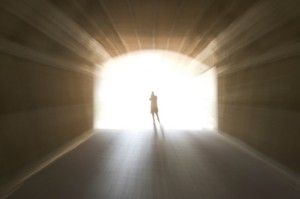 Perhaps as many as 5% of the population have OBE with no known brain pathology. Students experience them more often than the general population.
Perhaps as many as 5% of the population have OBE with no known brain pathology. Students experience them more often than the general population.
One common cause of OBEs is near-death experiences, known as NDEs. In a study of NDE after cardiac arrest and successful resuscitation, almost 20% included out of body experiences. This isn’t to say you should go out and buy an AED package to try and perform resuscitation on a friend or yourself to try and achieve a near-death experience.
OBE’s have been produced in otherwise completely normal people with electric currents from implanted electrodes in specific brain regions. Transcranial magnetic stimulation (discussed in relation to accidental savants in a previous post) applied to multisensory regions can also alter body perception.
OBE’s are described in different levels:
 First, sensing being near a person that you know is yourself, although you are still in your body.
First, sensing being near a person that you know is yourself, although you are still in your body.
Second, a fluctuation between being in your self and then being in the other person who can see yourself.
Third, leaving the body and observing it from outside, such as below you or next to you. A very unusual aspect of this is the fact that many also visualize the room or other people near them.
Fourth, returning to your body.
Sometimes it is a very pleasant experience. OBE’s often include loud noises, body vibrations, tingling, racing heartbeat, fearfulness, and confusion. Some believe that they are dead.
Manipulating Body consciousness with Virtual Machines
Recently, out of body experiences have been produced in very interesting experiments involving virtual reality devices.
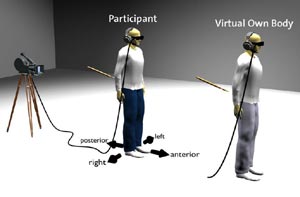 Full body illusions and out of body illusions can arise from presenting conflicts of vision and touch, and vision and position sense in experiments. These experiments involve the subject wearing virtual reality goggles. Subjects are then touched in the back while seeing only videos of another body being touched in that same location. Viewing themselves in a video also creates a third person perspective. Another example involves a camera viewing their body lying below while touching their back.
Full body illusions and out of body illusions can arise from presenting conflicts of vision and touch, and vision and position sense in experiments. These experiments involve the subject wearing virtual reality goggles. Subjects are then touched in the back while seeing only videos of another body being touched in that same location. Viewing themselves in a video also creates a third person perspective. Another example involves a camera viewing their body lying below while touching their back.
In both of these experiments people experience OBEs. There are many different brain regions that appear to take part in these illusions and there is therefore no simple explanation.
In other research manipulating body consciousness has been helpful in patients with paraplegia, amputations, artificial limbs, to feel artificial limbs as part of their real body. (See post on neuroplasticity).
Brain Theories
OBE’s were at first considered a psychosis, or depersonalization, but this is not consistent with current research.
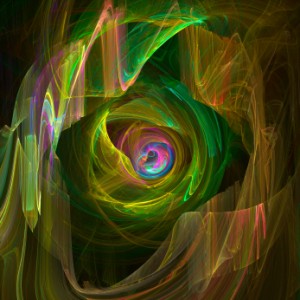 Previous posts have described how perceptions are largely created by expectations from the higher cortical regions, not just an analysis of sensory input. The brain ordinarily creates vivid experiences of the world both in lucid dreams and in waking. In some circumstances the brain does not have sensory input and therefore creates it’s own perceptions and scenarios about the body.
Previous posts have described how perceptions are largely created by expectations from the higher cortical regions, not just an analysis of sensory input. The brain ordinarily creates vivid experiences of the world both in lucid dreams and in waking. In some circumstances the brain does not have sensory input and therefore creates it’s own perceptions and scenarios about the body.
An ordinary example of the brain creating a new scenario could occur when a foot “falls asleep” by sitting on a nerve. This numb feeling could allow a different mental image of this limb. A change of perception can also occur for the entire body with paralysis from a stroke, temporary sleep paralysis, or cataplexy.
The brain regions that integrate multiple senses appear to be most important to our sense of self and body awareness. Our experience of bodily awareness is integrated from a wide variety of sensory signals. First visual, auditory, and touch information are processed in the primary sensory regions and then these integrated signals travel further in the brain circuits, joining other signals to form a perception. These signals include touch sensations of pain, heat, and cold. This is coordinated with senses from joints, tendons, and the inner ear about movement and position. These signals are further integrated with emotional data from internal body states including heart rate, breathing, and intestinal sensations. It is believed that a disruption of these integrated multisensory circuits leads to a change in our sense of body consciousness.
Separation from Body Consciousness
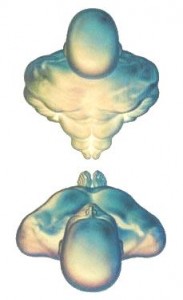 The fact that OBE’s can be stimulated in the laboratory clearly demonstrates that the sense of “I”, the self-identity, can be separated from the body consciousness. Studies of body maps are also consistent with this view because they show that body consciousness is constantly changing through neuroplasticity.
The fact that OBE’s can be stimulated in the laboratory clearly demonstrates that the sense of “I”, the self-identity, can be separated from the body consciousness. Studies of body maps are also consistent with this view because they show that body consciousness is constantly changing through neuroplasticity.
Therefore, ultimately, the sense of self is independent of the body sense, although normally extremely associated with it. The sense of “I,” or identity, is also ordinarily very attached to the self perceptions involving our professions, families, and other strongly held beliefs and feelings.
The narrative that we create for ourselves is also independent of this sense of “I”. One very interesting aspect of the self-narrative that is constantly being developed in our mind is its unusual relation to the sense of “I”. When we imagine either a past or future event or experience including ourselves, we visualize our place in this image in the third person. That is, we see and experience our body included in the scene with others. It is not visualized from the first person perspective.
 This same sense of third person is implicit in our almost universal description of “our body”, not, for example, “the body.” Saying “our body” implies that it is an object not the observer of the object. This is similar to the way we refer to our car, our house, or our profession. It is not “me””; it is “my car”, “my house”, or “my body”. The “I” or “Me” is something different.
This same sense of third person is implicit in our almost universal description of “our body”, not, for example, “the body.” Saying “our body” implies that it is an object not the observer of the object. This is similar to the way we refer to our car, our house, or our profession. It is not “me””; it is “my car”, “my house”, or “my body”. The “I” or “Me” is something different.
Posts have raised the question as to whether the sense of “I” is the same in waking, dreaming, deep sleep, and extraordinary states. For the same sense of “I” to be present in dreaming or deep sleep, there is clearly a different body sense
Studies on meditation show that the default mode network, DMN, is altered in advanced meditators. This means that the sense of identity is altered in meditation.
Studies on accidental savants show that there is alteration in the ordinary day to day sense of self to release the underlying extraordinary talents. Also, TMS released these talents by disrupting ordinarily used brain circuits that were inhibiting the unusual talents.
OBE’s seem to be triggered by a shift of perspective of the sense of “I” away from the body. In near death experiences, if there is awareness and self-identity at that moment, there is dissolution of the attachment to the body as well.
Will alterations in body attachment or the sense of “I” also be involved in the changes of mental state that occur in spiritual experiences and psychedelics? This will be discussed in the next post.